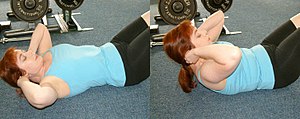Crunch (exercise)
The crunch is an abdominal exercise that works the rectus abdominis muscle.[1] It enables both building "six-pack" abs and tightening the belly. Crunches use the exerciser's own body weight to tone muscle and are recommended by some experts, despite negative research results, as a low-cost exercise that can be performed at home.[2] According to experts like Canadian biomechanics researcher Stuart McGill, crunches are less effective than other exercises such as planks and carry risk of back injury.[3]
Form[edit]
The biomechanics professor Stuart McGill was quoted in The New York Times Health blog as stating:
An approved crunch begins with you lying down, one knee bent, and hands positioned beneath your lower back for support. "Do not hollow your stomach or press your back against the floor", McGill says. Gently lift your head and shoulders, hold briefly and relax back down.[4]
McGill's further research however showed that both sit-ups and crunches are mediocre strength-building exercises and actually hurt many people.[3]
In a crunch, unlike a sit-up, the lower back stays on the floor. This is said to eliminate any involvement by the hip flexors, and make the crunch an effective isolation exercise for the abdominals.[5]
See also[edit]
References[edit]
- ^ "Core Anatomy: Muscles of the Core". www.acefitness.org. Retrieved 2022-03-28.
- ^ "Exercising on a budget". MedlinePlus Medical Encyclopedia. Retrieved 20 April 2020.
- ^ a b The Death of the Sit-Up - The Atlantic:
- [McGill's] findings showed that sit-ups and crunches weren't just mediocre strength-building moves; they were actually hurting lots of people.
- In the past decade, every branch of the U.S. military has begun to phase out sit-ups and crunches from their required testing and training regimens, or else they have made them optional, alongside more orthopedically sound maneuvers such as the plank. Spokespeople for the Army and the Marines confirmed [...] that these decisions in their branches were made in part to avoid the high rates of lower-back injury found among troops training for speed sit-up and crunch tests.
- If you hadn't yet noticed crunches disappearing around you—or if you have a trainer who still puts you through your sit-up paces—McCall said he wouldn't exactly be shocked. Like many other American industries, the fitness business is consolidating, but it still contains tons of independent instructors and small businesses. Sit-ups and crunches have been discouraged by educators within the industry for years, but there are no licensing or continuing-education requirements for teaching exercise, and if trainers don't seek out new information and techniques, it can take a while for good information and new ideas to get through to them. - ^ Reynolds, Gretchen (17 June 2009). "Is Your Ab Workout Hurting Your Back?". Well. The New York Times.
- ^ Baker, Cameron. "Are Sit Ups Bad for You? The U.S. Military Seems to Think So…". International Sports Sciences Association. Retrieved 17 October 2018.



No comments:
Post a Comment